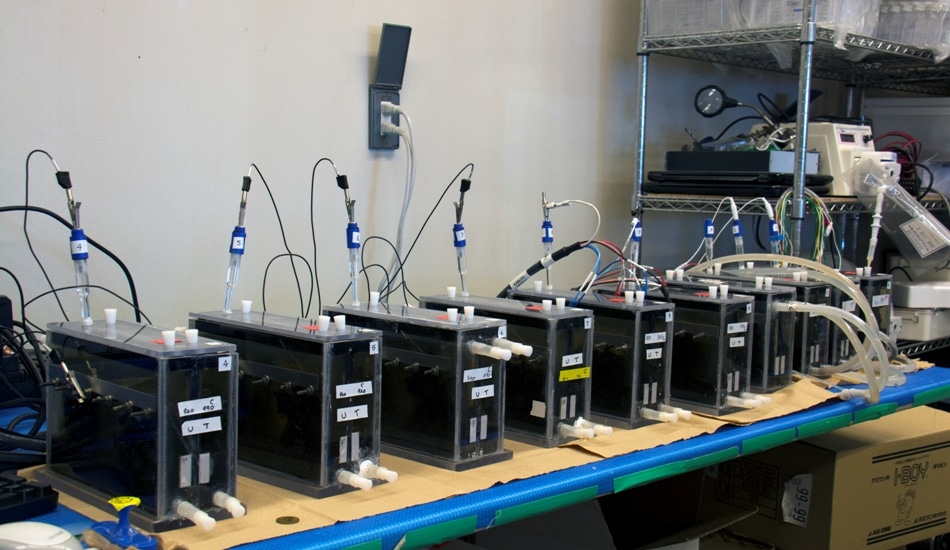Nov 17 2017
Today, wastewater left over from production undertakings is one of the greatest threats to the environment. Agricultural practices, such as pig farming, generate a large quantity of wastewater containing malodorous gases, organic contaminants, and other substances that are detrimental to the water supply.
Typical approaches of treating and recycling such wastewater include applying it as fertilizer to other farming areas, aeration, or confining it to dedicated ponds and wetlands to go through natural cleansing processes.
 MFCs in the OIST Biological Systems Unit lab containing treated and untreated wastewater from the Okinawa Prefectural Livestock and Grassland Research Center.( Photo: Okinawa Prefectural Livestock and Grassland Research Center)
MFCs in the OIST Biological Systems Unit lab containing treated and untreated wastewater from the Okinawa Prefectural Livestock and Grassland Research Center.( Photo: Okinawa Prefectural Livestock and Grassland Research Center)
However, in areas such as Okinawa, Japan, with restricted land resources and plenty of pig farms, the amount of wastewater created outweighs the land present for treatment and recycling. As such, there is a huge need to identify better, quicker and cheaper approaches of wastewater treatment, which is part of what gave rise to the formation of the Biological Systems Unit at the Okinawa Institute of Science and Technology Graduate University (OIST). Using a potential wastewater treatment technology, known as a microbial fuel cell (MFC), the Unit aims to assist the island—and by proxy, other locations with similar wastewater issues — decrease its wastewater problem.
An MFC is, in a sense, an anaerobic vessel of concentrated bacteria that feeds on biodegradable material and bacteria found in wastewater. It functions via bio-electrochemistry, meaning that the energy used to operate the cell is produced from electron transfer from the bacteria to electrodes within the device — no outer energy source is required. When wastewater passes through an MFC, the “feeding” bacteria digest the organic compounds in the wastewater and cleaner water is sent out the other side. Furthermore, the digesting process expels energy which is converted into working electricity. The end result is a device that cleans wastewater and generates electricity while doing so.
[The cells are] low maintenance, low cost and don’t have a lot of moving parts.
David Simpson, Technician, Biological Systems Unit, OIST
This is vital for those who do not have the resources or time to maintain costly treatment equipment — a description that fits the bill for stressed workers such as pig farmers.
Ideally what we’re working toward is to put the fuel cell [where you need it] and forget about it. It will monitor and treat the wastewater by itself.
Professor Igor Goryanin, Head of the Unit, OIST
Already the OIST researchers have created MFCs with the ability to run for prolonged time periods without “gunking” up or breaking down. At present, in a paper published in Scientifica, they have identified a method to reinforce the devices’ performance too. Prior to running an MFC, it has to be first cultured, or inoculated, with the “digesting” bacteria. To achieve this, one shovels sludge containing bacteria into a part of the MFC known as the anode. Here, the anticipated bacteria are propagated for later use in wastewater management.
In their research, the OIST team hypothesized that an MFC will be superior at treating wastewater if the anode is prepared with sludge that has been in earlier contact with that specific waste stream. They tested this hypothesis at a local pig farm run by the Okinawa Prefectural Livestock and Grassland Research Center in Nakijin, a village in the northern part of the island.
They used sludge gathered from a swine wastewater receiving tank at this farm, as well as sludge gathered from a wastewater reactor at a local brewery. In comparing the efficiency of the two types of MFCs, they discovered that the swine sludge MFC treated the pig farm wastewater a lot better than the one from the local brewery. The researchers used markers such as the removal rate of chemical oxygen demand and volatile fatty acids — pollutants of the water supply — as well as electricity generation, to evaluate this.
Besides the pig farm, the Unit has MFCs located at other sites in Okinawa and around the world — including an Awamori distillery in Okinawa, a winery in California, United States and a whisky distillery in Scotland. In California, the treated wastewater is being used for irrigation. The MFCs at the Awamori distillery site have been functioning for around five years. Simpson explains that, at present, these MFCs at the Awamori site are purifying the water to a certain level that allows for safe release into sewers.
“[We can] remove organics to a high degree, with about 90 percent efficiency,” Simpson explains. “But treating it releases ammonia and phosphates.” These are chemicals that can cause oxygen reduction in water as well as destructive algal blooms. “So we are trying to close the loop.” They are working to harvest the nutrients— ammonia, phosphate—at the lab scale.
The Unit is presently working with partners in the Okinawa Prefectural Livestock and Grassland Research Center and the Okinawa Environment Science Center, with funding from the Okinawa Prefecture Government, to formulate a solution for capturing and removing the nutrients, potentially resulting in valuable and sustainable byproducts for fertilizers.
The idea of wastewater treatment is to eventually help those countries without access to clean drinking water, perhaps by cleaning water to be used in potable wells.
Professor Goryanin
As for now, the OIST team will continue to test, run, and improve their MFCs with the anticipation that soon they may ease the wastewater burden of the world.